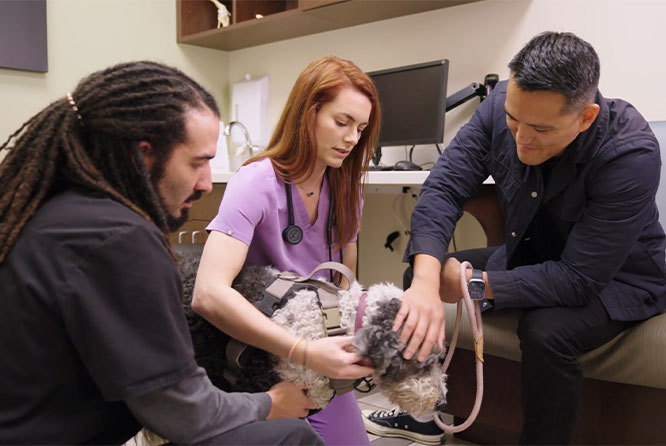Ehrlichia spp.: What’s par-TICK-ularly important? Copy

Diagnostic options for today’s clinically relevant vector-borne disease pathogens
Michelle Evason (BSc DVM DACVIM MRCVS)
Graham Bilbrough (MA VetMB CertVA MRCBS)
Antech • Mars Science & Diagnostics – Antech
When many of us first became veterinarians, Ehrlichia canis was the only Ehrlichia species we tended to consider, and for years, it was the only one included in reference lab and point-of-care tests. However, E. canis is just one branch on a much larger Ehrlichia spp. family tree. With climate change impacting tick numbers and abundance in both the U.S. and Canada, other Ehrlichia spp. have emerged in different parts of both countries. Today, we now recognize that these other Ehrlichia species, particularly E. ewingii and E. chaffeensis, are evolving and becoming increasingly important. Similar to the agent of Lyme disease, Borrelia burgdorferi, these Ehrlichia spp. are pathogens with dog and human implications, and dogs serve as sentinels for human risk due to common human environmental exposure from ticks.
Considering all of these vector changes, the diagnostic landscape must also evolve alongside emerging threats. That’s why Antech’s Accuplex™ was expanded to detect a broader range of Ehrlichia species. Likewise, Antech’s new in-hospital test, trūRapid™ FOUR, offers a similarly expanded test platform to support those preferring an in-clinic option for their workflow.
We understand that if we rely on outdated testing assumptions for Ehrlichia spp, we risk missing emerging pathogens of veterinary and human health importance. So, we decided to tackle some commonly asked questions about Ehrlichia spp. exposure, vector-borne disease screening, and what to do when you see more positive Ehrlichia results than you used to.
What’s the difference between Ehrlichia spp. exposure rather than disease? Can you help us understand what it might mean when we get a positive test result in a dog that is clinically normal?
It’s an important distinction to be aware of. When testing for vector-borne disease (VBD) pathogens, like Ehrlichia spp., it’s crucial to understand and differentiate pathogen exposure from active clinical disease to guide appropriate treatment decisions:
- Exposure (Seropositivity): A positive antibody test result indicates that a dog has been exposed to the pathogen transmitted by the biting vector (e.g. tick) and then gone on to develop antibodies. But, and here’s what can be the ‘tricky bit’, that doesn’t always mean the dog has an active infection, clinical disease, or requires medical treatment. Importantly, and fortunately, many dogs exposed to pathogens like Ehrlichia never develop signs of clinical disease. However, knowing that a dog is positive through screening sends an alert regarding risk exposure and emphasizes the importance of prevention—and informing risk for the dog’s human family members. And if that dog is negative, the vet team can cheer compliance and celebrate the negative—and continue to reinforce the value of screening and prevention.
- Disease: Occurs when the pathogen is actively causing harm and clinical signs; for Ehrlichia infection, it can lead to symptoms like fever (pyrexia), joint pain, anemia, and others. For clinical case presentations like this, or when suggestive clinicopathologic changes are noted on a CBC (e.g. thrombocytopenia), additional testing, like a CBC if this hasn’t been performed, and PCR, may be needed to determine the cause of the clinical signs or changes. This is because an antibody response can take time to develop, and serology testing (antibody screening) will not be able to diagnose the acute stage of illness, since in some cases, antibodies will not yet have had time to develop. This is referred to as diagnostic stewardship, i.e. using the right test, at the right time, so that the best diagnosis is made and treatment choices (like antimicrobials) are used appropriately.
Q: I’m finding a lot more Ehrlichia positives than I used to, but few of them have clinical signs. Why?
Puns aside, it’s par-TICK-ularly important to remember that antibody detection—whether with Accuplex or trūRapid FOUR—indicates exposure to a VBD pathogen, not necessarily current or active disease. Indeed, most exposed dogs will not show clinical signs at the time of screening. Additionally, now that Ehrlichia ewingii is included in diagnostic panels, we should be mindful that it causes different clinical signs than Ehrlichia canis:
- E. ewingii tends to cause muscle pain and is often mild or subclinical.
- E. canis, on the other hand, is more likely to cause spontaneous bleeding, anemia, or thrombocytopenia, and if untreated, or treated inappropriately, can cause a chronic disease state.
Because this diagnostic testing is designed to identify exposure to VBD pathogen-transmitting ticks through identification of a dog’s antibody response, expanding test detection to include the increased number of Ehrlichia species that are now present in the U.S. and Canada is important. However, as a result, your clinical experience with Ehrlichia-positive dogs may shift, with more positive test results in asymptomatic cases than before simply because more dogs have been exposed.

Q: I’m getting dogs with positive results, what is the best course of action? How do I decide whether to treat or not?
Antech has some great clinical algorithms referenced at the end of this article that will help you decide on the next steps.
Q. What is the relationship of VBD pathogens, like Ehrlichia, to One Health?
VBD pathogens are a perfect example of why a One Health approach is essential in today’s veterinary landscape- and in one’s clinic. These diseases don’t just affect dogs—they exist at the intersection of animal health, human health, and environmental (climate, wildlife) change- in addition to having antimicrobial use and stewardship implications
Shared Risk Between Animals and Humans:
- When it comes to Ehrlichia spp. there has been a rapid rise in ehrlichiosis case numbers in humans in the U.S. Combined with lower ehrlichiosis awareness among human health care providers, and higher illness severity when compared to Lyme disease, human medical subcommittees have been formed to aid awareness, particularly for E. chaffeensis.
- By monitoring trends in canine exposure, veterinarians performing the advised screening enable dogs to serve as sentinels for their human family’s disease risks and for the broader community.
Q: Why is it so important for all dogs to be screened for VBD?
Vectors like ticks are notorious for spreading infection—even the smallest tick nymph can transmit harmful pathogens—and they can cause serious, often life-threatening disease in humans, too. Pets are sentinels for VBD, and they continue to be our very best friends by helping us understand our own risk for disease and the need for prevention for ourselves and our families. We have an obligation to protect the pets we treat and the humans that love them.
From a One Health point of view, we as veterinary professionals must understand and share the knowledge with pet owners that, due to climate change and other factors like travel and dog importation, past conditions surrounding VBD pathogen risk may no longer be applicable. Just as we must adapt to the warming climate on a human level, we must also adapt to the changes in how we practice medicine to prevent and/or treat VBD.
—
How to Access Antech’s Clinical Decision-Making Algorithm: Visit the Accuplex Resource Center link here
Companion Animal Parasite Council (CAPC) Intestinal Parasite Guidelines. As accessed April 2025: https://capcvet.org/guidelines/Canadian Parasitology Expert Panel (CPEP) Guidelines for the Management of Parasites in dogs and cats, 2019. As accessed April 2025: https://research-groups.usask.ca/cpep/index.php#Protocol



